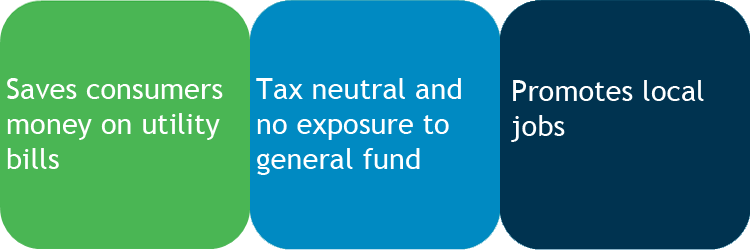Referred to as tax-lien financing, Property Assessed Clean Energy (PACE) is an innovative way to finance energy efficiency and renewable energy upgrades to buildings.
Interested property owners evaluate measures that achieve energy savings and receive 100% financing, repaid as a property tax assessment for up to 20 years. The assessment mechanism has been used nationwide for decades to access low-cost long-term capital to finance improvements to private property that meet a public purpose. By eliminating upfront costs, providing low-cost long-term financing and making it easy for building owners to transfer repayment obligations to a new owner upon sale, PACE overcomes challenges that have hindered adoption of energy efficiency and related projects in our nation’s buildings.
PACE is a local government/community initiative that creates permanent private sector jobs, strengthening our national and local economies. Buildings use nearly half of the energy we consume in the United States. PACE programs help make our nation more energy independent and secure while safeguarding our environment by reducing demand for fossil fuels. The PACE financing mechanism provides a strong credit that is attractive to private sector investors and without government subsidies. PACE is voluntary. Property owners, acting in their own self-interest, implement building upgrades that can save them money, increase the value of their property. PACE programs add value, and have gained bi-partisan support nationwide at federal, state and local levels.
Introduced in pilot programs in 2008, PACE made immediate sense to energy efficiency advocates across the country, and today, 31 states and the District of Columbia have adopted (or already had) legislation that enables local governments to offer PACE benefits to building owners.
Benefits of PACE
PACE drives spending in the local communities through the implementation of energy efficient and renewable energy systems. Major benefits of PACE are:

Both commercial and residential PACE improve consumer’s cash flow by decreasing energy needs and hence decreasing utility bills. PACE, compared to other retrofit mechanisms, is tax neutral and results in no exposure to county’s general fund. An economic study performed by ECONorthwest in 2011 predicts that every $1 million of EE/RE project spending results in $2.5 million in total economic output, roughly $250 thousand in state and local taxes, and approximately 15 new jobs nationwide.
Another study conducted in 2011 by the United States Department of Energy on the economic impacts of the Boulder County (CO) Climate Smart (PACE) Loan Program found that $9 million spent on EE/RE projects on 598 homes contributed, statewide, to more than $7 million in personal income gains, just under $30 million of total economic activity, and the creation of roughly 125 short-term jobs.
How PACE Works?
There are 4 simple steps to every PACE programs:

PACE uses the same kind of land‐secured financing districts that American cities and towns have used for over 100 years to pay for improvements in the public interest. Over 37,000 land secured districts already exist and are a safe and familiar tool of municipal finance for street paving, parks, open space, water and sewer systems, street lighting, and seismic strengthening, among others.
PACE Programs
PACE programs work at the local municipal level and program elements vary to meet the needs of individual communities and reflect differences in state laws. Most PACE programs will share basic features:
- State and local governments establish, in law or public policy, a specific goal or objective: promoting energy efficiency as a means to promote jobs or better air quality, for example.
- A municipal government may establish a type of land or real property secured benefit district.
- Property owners within the district (or the municipality if a district is not required) can voluntarily choose to participate; those who choose not to see no change to their taxes and assessments.
- An experienced contractor will assess the scope of desired improvements. This may involve a thorough energy audit for efficiency measures and their projected savings and costs, or cost estimates for renewable projects weighed similarly against projected energy savings.
- The municipality will provide financing for the project, typically by selling bonds secured solely by payments made from participating property owners.
- Homeowners who receive a financing benefit from the municipality will agree to accept a property tax assessment or charge for up to 20 years, though shorter periods may be chosen or required by the municipality.
Is PACE near you?
The PACE program had been adopted in several counties throughout the state of Florida. Pasco County most recently established a PACE Program, and soon, Pinellas County will be a part of the PACE Program.
Contact Smart Energy to learn more about PACE Program in your area.
